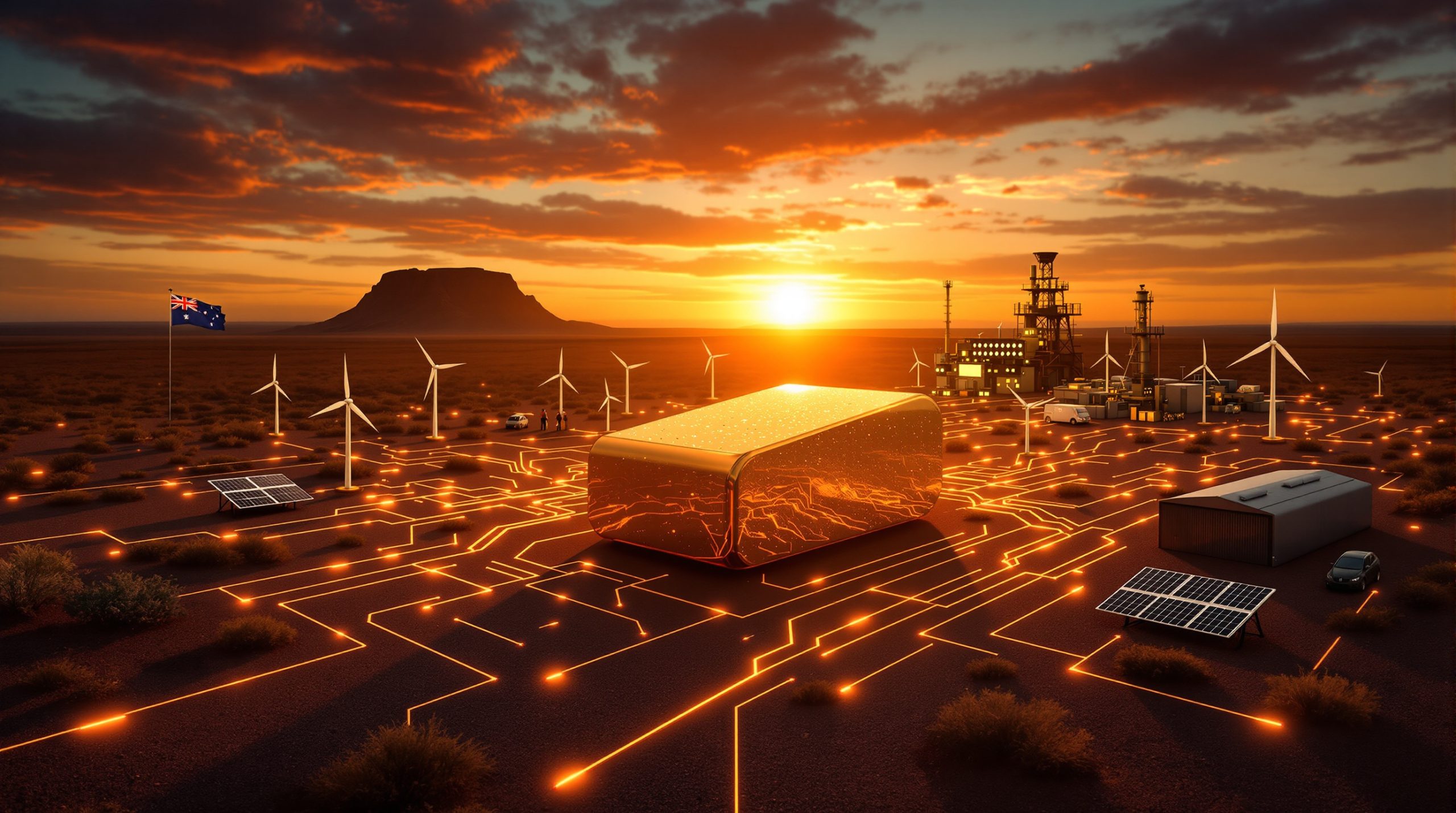Why Is Copper Demand Expected to Surge?
The Electrification Revolution
Global copper demand is projected to increase dramatically, with industry leaders forecasting a rise of up to 70% by 2050 compared to 2021 levels. Currently, global refined copper consumption stands at approximately 27 million tonnes annually, but this is expected to reach 33 million tonnes by 2035 and climb further to 37 million tonnes by 2050.
This growth trajectory represents a significant acceleration from historical trends. While copper demand grew at a compound annual growth rate (CAGR) of 1.9% between 2006 and 2021, projections now indicate this will increase to 2.6% through 2035, reflecting the metal's increasingly critical role in global electrification.
BHP CEO Mike Henry emphasized this point in a recent CNBC interview, noting that "copper will be essential to the world's energy future, with copper demand growth fundamentally driven by the global transition to clean energy technologies and electrification."
Critical Role in Energy Transition
The renewable energy sector is a particularly copper-intensive industry. Wind turbines require between 2.5 and 6.4 tonnes of copper per megawatt, depending on whether they're onshore or offshore installations. Solar photovoltaic systems similarly demand between 2.8 and 4.8 tonnes of copper per megawatt.
Electric vehicles represent another major growth driver for copper demand. Each EV contains approximately 180 pounds (82 kg) of copper – two to four times the amount found in conventional internal combustion engine vehicles. This increased copper intensity stems from the metal's use in batteries, wiring harnesses, electric motors, and inverters.
The EV charging infrastructure itself creates additional demand. A single charging station can contain 0.7 kg (for a slow charger) to over 8 kg (for a fast charger) of copper, with the associated cabling requirements adding substantially more.
Meanwhile, power grid modernization and expansion to accommodate renewable energy sources and increased electricity demand will require massive copper investment strategies to meet future needs. Transmission lines, transformers, and distribution equipment all rely heavily on copper's superior conductivity properties.
How Is the AI Revolution Amplifying Copper Demand?
Data Centers and Digital Infrastructure
The artificial intelligence boom is creating a new and rapidly growing source of copper demand that wasn't fully factored into earlier forecasts. Modern data centers represent one of the most copper-intensive commercial building types, requiring extensive copper for:
- Power delivery systems – Including busbars, cables, transformers, and uninterruptible power supplies
- Cooling infrastructure – Copper heat exchangers, chiller systems, and cooling lines
- Data transmission networks – Server connections, network cabling, and telecommunications equipment
According to industry analysis, a typical large-scale data center can contain hundreds of tonnes of copper. The current AI-driven expansion of data center capacity worldwide is creating significant additional demand pressure on copper markets.
As BHP CEO Mike Henry noted in his October 2025 CNBC interview, "The AI revolution is driving unprecedented data center construction, with each new facility requiring substantial copper infrastructure that wasn't anticipated in earlier demand forecasts."
Technological Advancement
Beyond data centers, broader technological advancement continues to drive copper consumption. Semiconductor manufacturing requires high-purity copper for interconnects and advanced packaging. The ongoing miniaturization of electronic components actually increases copper intensity in many applications, as more complex circuitry is packed into smaller spaces.
Advanced computing and telecommunications infrastructure, including the global 5G network rollout and eventual 6G development, rely heavily on copper components. The metal's unique combination of conductivity, durability, and malleability makes it difficult to replace in many high-performance applications.
Smart city technologies and Internet of Things (IoT) devices further increase copper intensity in urban environments. From traffic management systems to smart grid components, these technologies embed copper throughout urban infrastructure.
What Regional Shifts Are Occurring in Copper Demand?
Evolving Consumption Patterns
China has dominated global copper consumption for decades, currently accounting for approximately 60% of world demand. This concentration has created significant market dependencies and vulnerabilities in the global supply chain.
However, demand growth is diversifying geographically as multiple regions pursue ambitious electrification and decarbonization targets:
-
North America is accelerating renewable energy deployment under various federal and state initiatives. The Inflation Reduction Act and infrastructure legislation are driving substantial investments in grid modernization, EV charging networks, and clean energy manufacturing.
-
Europe continues to pursue aggressive decarbonization goals through the European Green Deal and Fit for 55 package. These initiatives mandate rapid deployment of renewable energy, energy storage, and electrified transportation systems.
-
Developing economies across Southeast Asia, Latin America, and parts of Africa are increasing electrification efforts and infrastructure investment, creating new centers of copper demand growth.
This geographic diversification may help reduce market volatility by creating multiple demand centers rather than a single dominant consumer.
Urbanization and Economic Development
Developing economies, with populations nearly five times larger than high-income countries, represent a significant driver of future copper demand growth. Rising living standards consistently correlate with increased copper consumption per capita.
Infrastructure development in emerging markets requires substantial copper resources. From basic electricity access to modern transportation systems, copper forms the backbone of development infrastructure.
The urbanization trend further amplifies copper demand, as cities require more intensive electrical infrastructure than rural areas. With the UN projecting that 68% of the world's population will live in urban areas by 2050 (up from 55% today), this represents a structural increase in copper intensity per capita.
What Supply Challenges Are Emerging?
Current Production Landscape
While demand projections show robust growth, the supply side faces significant challenges. Global mined copper output is expected to grow by approximately 2.3% in 2025, with refined production projected to increase by nearly 3% in the coming year.
However, major supply disruptions have created market imbalances. The closure of the Cobre Panamá mine removed approximately 300,000 tonnes of annual production capacity from global supply. Similarly, Anglo American's output reductions have affected global copper supply forecast.
These disruptions highlight the vulnerability of copper supply chains to both operational and political risks, creating greater price volatility and supply uncertainty.
Structural Supply Constraints
Several structural factors constrain the industry's ability to rapidly increase production:
-
Declining ore grades at existing mines – The average copper content in mined ore has fallen from approximately 0.9% in the 1990s to around 0.5% today. This decline requires mining companies to process more material to produce the same amount of copper, increasing costs and environmental impacts.
-
Lengthening permitting processes – New copper projects typically take 5 to 15+ years from discovery to production, with permitting often being the longest phase. This extended timeline creates a significant lag between demand signals and supply response.
-
Environmental regulations – Increased focus on environmental protection has raised compliance costs and operational complexity for mining companies. Water usage limitations, tailings management requirements, and emissions restrictions create additional challenges.
-
Political risks in key producing regions – Chile and Peru, which together account for approximately 40% of global copper production, have experienced political instability and resource nationalism trends that affect investment certainty.
As BHP's CEO noted in his CNBC interview, "The permitting process for new mining operations has become increasingly complex and time-consuming, creating a significant obstacle to meeting future copper demand."
How Are Market Dynamics Responding?
Price Implications and Forecasts
The emerging supply-demand imbalance has significant implications for copper prices. Leading financial analysts are projecting potential copper price prediction insights indicating increases of 75% or more by 2025, with the possibility of prices exceeding $15,000 per tonne amid sustained deficits.
Goldman Sachs has forecast a deficit exceeding 500,000 tonnes in 2024, creating upward pressure on prices. The investment bank's analysis suggests copper could become one of the best-performing commodities of the decade as structural shortages emerge.
Price volatility is also expected to increase as the market responds to supply disruptions against a backdrop of inelastic demand from critical infrastructure sectors, as noted in a recent analysis by The Guardian.
Supply-Demand Balance Outlook
While short-term fluctuations are possible due to factors like Chinese economic slowdown affecting construction-related demand and temporary destocking cycles in manufacturing, the long-term structural deficit appears increasingly likely as the energy transition accelerates.
The growing gap between production capacity and consumption requirements creates a fundamental market imbalance. Industry analysts project that even with aggressive investment in new production capacity, supply growth will struggle to keep pace with demand through most of this decade.
This outlook has prompted mining companies to reevaluate their copper strategies and accelerate exploration and development activities, though the long lead times for new projects mean any supply response will take years to materialize.
What Are the Investment Implications?
Strategic Resource Recognition
Copper is increasingly viewed as a critical resource for energy security and industrial policy. Major economies including the United States, European Union, and China have designated copper as a strategic mineral essential for economic and national security.
This recognition has led to policy developments aimed at securing copper supply chains, including:
- Strategic mineral stockpiling programs
- Investment incentives for domestic production
- International agreements to secure supply access
- Research funding for extraction technologies and recycling
Major mining companies are responding by prioritizing copper in their investment portfolios. BHP, Rio Tinto, Freeport-McMoRan, and other industry leaders have shifted capital allocation to favor copper over other commodities, reflecting its strategic importance and favorable price outlook.
Project Development Acceleration
The anticipated supply deficit has triggered increased capital allocation to copper exploration and development. Mining companies and investors are showing renewed interest in previously marginal deposits as higher price expectations improve project economics.
Innovation in extraction and processing technologies is receiving greater attention and funding as companies seek to:
- Develop economically viable methods for processing lower-grade ores
- Reduce water and energy requirements in copper production
- Minimize environmental impacts of mining operations
- Accelerate project development timelines
The Resolution Copper Project in Arizona exemplifies this trend. As noted by BHP's CEO in his CNBC interview, this project could supply approximately 25% of US copper project insights show its strategic significance for North American supply security.
How Can the Supply Gap Be Addressed?
New Project Development
Several major copper projects are in various stages of the development pipeline, though most face significant regulatory and environmental hurdles before reaching production:
- Resolution Copper (Arizona, USA) – A joint venture between Rio Tinto and BHP with the potential to supply a quarter of US copper demand
- QB2 (Chile) – Teck Resources' expansion project that will significantly increase Chilean production
- Oyu Tolgoi Underground (Mongolia) – Rio Tinto's expansion of one of the world's largest copper-gold mines
- Kamoa-Kakula (Democratic Republic of Congo) – Ivanhoe Mines' phased development of a major new copper district
Additionally, numerous exploration projects are underway in established mining jurisdictions like Chile, Peru, Australia, and Canada, as well as emerging regions in Central Africa, Central Asia, and Southeast Asia.
Recycling and Circular Economy
Secondary copper production (recycling) currently provides approximately 30% of global supply, offering a significant opportunity to address part of the looming supply gap. Unlike many materials, copper can be recycled indefinitely without loss of performance, making it ideal for circular economy approaches.
The potential exists to increase recycling rates through:
- Improved collection systems for end-of-life products
- Advanced sorting technologies to separate copper from mixed waste streams
- More efficient processing methods to recover copper from complex materials
- Economic incentives to encourage recycling and reuse
Urban mining of electronic waste is becoming increasingly economical as copper prices rise and technology improves. The growing stockpile of end-of-life electronics represents a significant potential copper resource that could help alleviate primary supply pressures, according to a comprehensive IEA report on copper.
Technological Innovation
Technological innovation offers several pathways to address the copper supply challenge:
- Advancements in extraction technologies for lower-grade ores, including bioleaching and advanced flotation methods
- Improvements in processing efficiency to reduce energy and water requirements
- Development of substitutes for certain applications to alleviate demand pressure where technically feasible
- Thrifting strategies to reduce copper intensity in specific products while maintaining performance
While substitution has limits due to copper's unique properties, alternatives like aluminum can replace copper in some applications where weight is a priority or where extreme conductivity isn't required.
What Are the Environmental Considerations?
Sustainability Challenges
Copper mining faces significant environmental challenges that must be addressed as production expands:
- Water usage concerns in arid mining regions, with some operations requiring millions of gallons daily
- Energy intensity of extraction and processing, contributing to carbon emissions
- Waste management and tailings storage requirements presenting long-term environmental risks
- Land disturbance and habitat impacts from large-scale mining operations
These environmental factors create complex trade-offs as society balances the need for copper to enable the clean energy transition against the environmental impacts of producing it.
Balancing Priorities
Copper's essential role in enabling renewable energy, electric vehicles, and energy efficiency technologies creates a complex sustainability equation. The metal is indispensable for technologies that reduce carbon emissions, yet its production has significant environmental impacts.
This paradox requires a balanced approach:
- Implementing responsible mining practices that minimize environmental footprint
- Developing more efficient extraction and processing technologies
- Maximizing recycling and circular economy approaches
- Creating appropriate regulatory frameworks that enable production while ensuring environmental protection
The mining industry has responded with growing emphasis on ESG (Environmental, Social, and Governance) performance in project development and operations. Major companies are setting ambitious sustainability targets, including water recycling requirements, renewable energy use at mine sites, and biodiversity protection programs.
Frequently Asked Questions About Copper Demand
How much copper is required for the energy transition?
The International Energy Agency projects that achieving net-zero emissions by 2050 will require a four-fold increase in mineral demand for clean energy technologies by 2040, with copper being one of the most critical materials. Specifically, clean energy technologies may require more than 50 million tonnes of additional copper between now and 2050, representing a significant portion of the projected demand growth.
Will recycling solve the copper supply challenge?
While recycling currently provides approximately 30% of copper supply and has potential to increase, the projected growth in overall demand means primary production must still expand significantly to meet future needs. Even with optimistic recycling rate improvements, new mining production will be essential to bridge the supply gap.
Which countries have the largest copper reserves?
Chile leads global copper reserves, accounting for approximately 23% of known resources, followed by Peru, Australia, and the United States. However, resource nationalism in some major producing countries has created uncertainty about future access to these reserves, prompting increased exploration in more stable mining jurisdictions.
How does copper demand correlate with economic development?
Historically, copper consumption has closely tracked economic development, with per capita usage increasing as countries industrialize and living standards rise. Developed economies typically consume 5-10 kg of copper per person annually, while developing economies may use less than 2 kg per person, suggesting significant growth potential as these economies develop.
What impact will AI have on copper demand?
The AI revolution is creating a new source of copper demand through data center construction and digital infrastructure expansion, potentially accelerating consumption beyond previous forecasts. Each new AI-focused data center requires significant copper for power distribution, cooling systems, and data transmission, creating additional pressure on an already constrained market.
Looking for the Next Major Copper Discovery?
Discover significant ASX copper exploration announcements the moment they're released with Discovery Alert's proprietary Discovery IQ model, giving you a crucial edge in identifying potentially transformative discoveries before the broader market. Visit our discoveries page to explore how major mineral discoveries have historically delivered exceptional returns for early investors.




